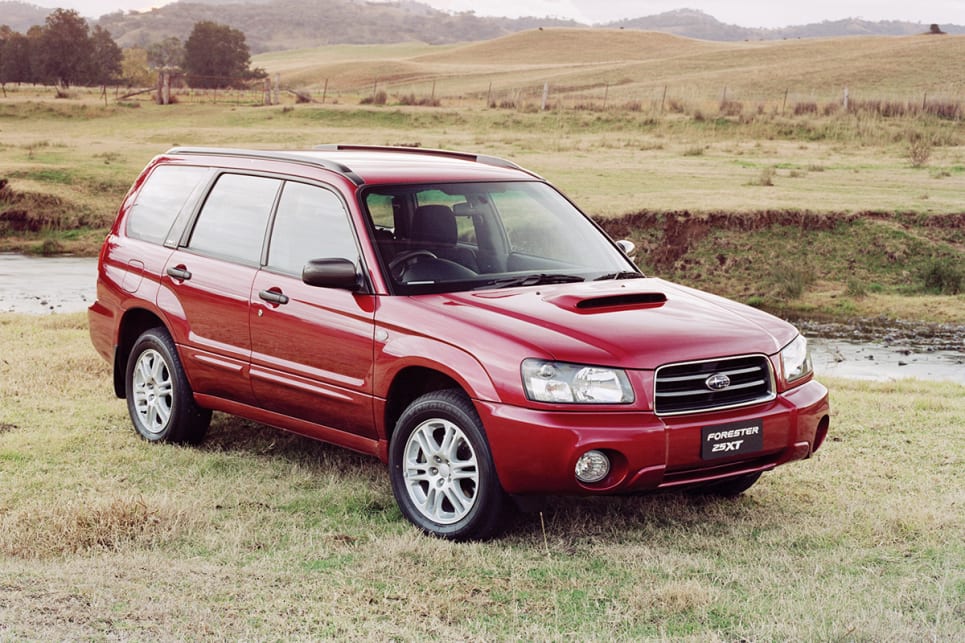First generation (SF; 1997)
The Forester was introduced at the Tokyo Motor Show in November 1995 as the Streega concept, and made available for sale in February 1997 in Japan, and to the US market in 1997 for MY1998. The Forester was one of the first emerging crossover SUVs. It was built in the style of a car, but had a taller stance, higher h-point seating, and an all-wheel drive drivetrain. Subaru advertising employed the slogan "SUV tough, Car Easy". It used the Impreza platform but with the larger 2.5-liter DOHC EJ25D four-cylinder boxer engine from the Subaru Outback, making 123 kW (165 hp; 167 PS) at 5,600 rpm and 220 N⋅m (162 lb⋅ft) of torque at 4,000 rpm.
Second generation (SG; 2002)
The second generation was introduced as a 2003 model at the 2002 Chicago Auto Show, based on the new Impreza platform, featuring several fine-tune improvements over the past model. The 2003 Forester features weight-saving refinements such as an aluminum hood, perforated rails, and a hydro-formed front sub-frame. The most noticeable change was the offering of 2.5 L versions (normally aspirated and turbocharged) and in the U.S. the introduction of the turbocharged 2.5-liter model.
Forester STi (SF and SG; 2000)
Third generation (SH; 2009)
The third generation Forester began to move away from a traditional wagon design towards becoming a crossover SUV. It was larger in nearly every dimension and featured a sloping roof line with more cargo space. Subaru unveiled the model year 2008 Forester in Japan on December 25, 2007. The North American version made its debut at the 2008 North American International Auto Show in Detroit.
Styling was by Subaru Chief Designer Mamoru Ishii.[15] The dimensions derive from engineers using the basic body structure of the Japanese-spec Impreza wagon with the rear platform of the U.S.-spec Impreza sedan.[15] The Forester's wheelbase was increased 3.5 inches (89 mm), with overall increases of 3.0 inches (76 mm) in length, 1.8 inches (46 mm) in width and 4.3 inches (110 mm) in height
Fourth generation (SJ; 2014)
The fourth-generation Forester was unveiled in the 2012 Guangzhou Motor Show,[31] followed by the 2013 New York International Auto Show.[32]
Changes to the line-up include:
- Continuously Variable Transmission and decreased towing capacity. Maximum towing capacity was reduced to 1,500 lb (680 kg) across all trim lines (in the United States; overseas the towing capacity is double that). Turbocharged variants use a high-torque CVT with steering wheel paddle shifter controls.
- Revised, sport-oriented suspension, wheels (18-inch) and chassis bracing for XT (turbo) variant, providing flatter cornering in turns and better handling overall with little impact on ride.
- Increased fuel economy, up to 32 mpg (7.35 L/100 km) highway (EPA rated)
- 1.4 inches longer, 0.6 inches wider, 1 inch longer wheelbase
- Increased interior volume: rear seat legroom is 41.7 inches (1,060 mm) and rear cargo volume (with seats folded down) is 74.7 cubic feet (2.12 m3).[33]
- New option on higher end CVT models is "X-MODE" AWD control system, which was developed for driving on uneven or slippery road conditions. Engine, Transmission and VDC are controlled cooperatively.[34][35]
- New option on top of the line 2.5i and 2.0XT Touring models only: EyeSight Driver Assist System
Fifth generation (SK; 2019)
Mechanical features[edit]
All 2019 Subaru Foresters have one of three versions of Subaru's Symmetrical All Wheel Drive (AWD) system. The trim level determines which system is installed. All provide a nominal torque split biased 60 front to 40 rear.
- Base: Variable Torque Distribution (VTD) utilizing electronically controlled clutches to control torque split.
- Premium: enhanced “X-Mode” which is a Single Mode System that optimizes engine output and transmission ratio. It enhances control of the VDC system to further control wheelspin and incorporates Hill Descent Control (HDC).
- Sport, Limited and Touring: further enhanced “Dual Function X-Mode” System that adds specific, user engaged, settings for Snow/Dirt and Deep Snow/Mud modes.






.jpg)






